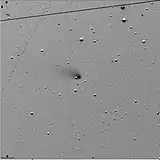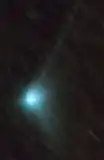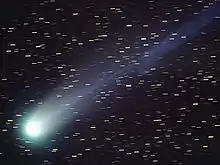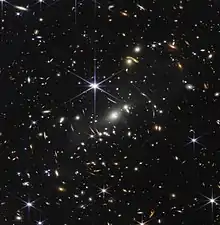-_Alessandro_Bianconi.jpg.webp) C/2022 E3 (ZTF) on 27 January 2023 | |
| Discovery | |
|---|---|
| Discovered by | Zwicky Transient Facility |
| Discovery date | 2 March 2022[1] |
| Orbital characteristics | |
| Observation arc | 456 days |
| Number of observations | 3382 |
| Orbit type | Long-period comet |
| Aphelion | ≈2800 AU (barycentric epoch 1950)[2] |
| Perihelion | 1.112 AU[3] |
| Eccentricity | 0.999988 (barycentric epoch 2050)[4] |
| Orbital period | ≈50,000 yr (inbound)[2] Possible Ejection (outbound)[4] |
| Inclination | 109.17° |
| Last perihelion | 12 January 2023[3] |
| Earth MOID | 0.221 AU (33.1 million km)[3] |
| Jupiter MOID | 1.743 AU (260.7 million km) |
| Physical characteristics | |
| Dimensions | ≈1 km[5] |
| Comet total magnitude (M1) | 10.5±0.6[3] |
C/2022 E3 (ZTF) is a non-periodic comet from the Oort cloud that was discovered by the Zwicky Transient Facility (ZTF) on 2 March 2022.[1] The comet has a bright green glow around its nucleus, due to the effect of sunlight on diatomic carbon and cyanogen.[6][5] The comet's systematic designation starts with C to indicate that it is not a periodic comet, and "2022 E3" means that it was the third comet to be discovered in the first half of March 2022.[5]
The comet nucleus was estimated to be about a kilometer in size,[7] rotating every 8.5[8] to 8.7 hours.[9] Its tails of dust and gas extended for millions of kilometers and, during January 2023, an anti-tail was also visible.[10]
The comet reached its perihelion on 12 January 2023, at a distance of 1.11 AU (166 million km; 103 million mi), and the closest approach to Earth was on 1 February 2023, at a distance of 0.28 AU (42 million km; 26 million mi). The comet reached magnitude 5 and was visible with the naked eye under moonless dark skies.[11][12][13][14]
Observational history
Discovery
Astronomers Bryce Bolin and Frank Masci discovered C/2022 E3 (ZTF) using the Zwicky Transient Facility (ZTF) survey, which uses the 1.2-m f/2.4 Schmidt telescope at Palomar Observatory, on 2 March 2022.[1] Upon discovery, the comet had an apparent magnitude of 17.3 and was about 4.3 AU (640 million km; 400 million mi) from the Sun.[1][15]
The object was initially identified as an asteroid, but subsequent observations revealed it had a very condensed coma, indicating it is a comet.[16] H. Sato reported its coma was 8 arcseconds across in stacked photos he obtained from the remote observatory in Mayhill, New Mexico, while K. Yoshimoto reported its coma was 15 arcseconds across and the comet had a small tail 25 arcseconds long.[1][15]
The comet was subsequently detected in images taken by Pan-STARRS 1 in Haleakalā Observatory, Hawai'i on 10 July 2021, when the comet had an apparent magnitude of 23. The comet had also been photographed without being noticed by ZTF in October and November 2021.[17]
Near perihelion
By early November 2022, the comet had brightened to magnitude 10 and was appearing to move slowly in Corona Borealis and Serpens as it moved parallel to Earth.[18] The comet exhibited a green coma and a yellowish dust tail and a faint ion tail. The comet was visible in the early evening and started being visible in the morning sky by the end of November.[19] By 19 December, the comet had developed a greenish coma, a short, broad dust tail, and a long faint ion tail stretching across a 2.5-degree wide field of view.[20] After that, the comet started moving northward, passing through Boötes, Draco, and Ursa Minor, passing within about 10 degrees of Polaris by the end of January.[19][21]

The comet reached its perihelion on 12 January 2023, at a distance of 1.11 AU (166 million km; 103 million mi).[22][23] The first naked-eye observations of the comet occurred on 16 and 17 January, with the comet having an estimated magnitude of 5.4 and 6.0 respectively.[24] Strong solar wind from a coronal mass ejection caused a disconnection event of the ion tail of the comet on 17 January, making it appear broken.[25] On 22 January an anti-tail became visible. This tail appears pointing toward the Sun and opposite the dust and ion tails. It is caused by particles lying on a disk on the orbital plane of the comet, and when Earth aligns with that plane, they look like a reverse tail.[26][27] XMM-Newton X-ray space telescope observed the comet on 23 January, but it was only faintly detected.[28][29]
The comet's closest approach to Earth was on 1 February 2023, at a distance of 0.28 AU (42 million km; 26 million mi). As of 31 January 2023, the comet had an apparent magnitude of about 5; its coma was reported to be about 20' across.[11] During its closest approach to Earth, it was near the north celestial pole[30] and located within the Camelopardalis constellation.[31] The moon was a waxing gibbous and the brightening moon hampered viewing the comet without optical aid.[32] On 5 February, at the full moon, the comet passed 1.5 degrees from the bright star Capella.[32] On 6 February, C/2022 E3 (ZTF) visually passed near comet C/2022 U2 (ATLAS).[33] On 10 to 11 February, the comet passed 1.5 degrees from Mars and, on 13 to 15 February, passed in front of the Hyades star cluster.[19]

| Date and time of closest approach |
Earth distance (AU) |
Sun distance (AU) |
Velocity relative to Earth (km/s) |
Velocity relative to Sun (km/s) |
Uncertainty region (3-sigma) |
Lunar elongation |
Lunar phase |
Reference |
|---|---|---|---|---|---|---|---|---|
| 2023-02-01 17:55 | 0.2839 AU (42.47 million km; 26.39 million mi; 110.5 LD) | 1.159 AU (173.4 million km; 107.7 million mi; 451 LD) | 57.4 | 39.1 | ± 500 km | 44° | 86% | Horizons |
Color
The green color is likely due to the presence of diatomic carbon, chiefly around the comet's head.[34][35] The C2 molecule, when excited by the solar ultraviolet radiation, emits mostly in infrared, but its triplet state radiates at 518 nm (nanometers). It is produced by photolysis of organic materials evaporated from the nucleus. It then undergoes further photolysis, with a lifetime of about two days, at which time the green glow appears in the comet's head but not the tail.[36][37] The comet researcher Matthew Knight opined that the green color of this comet is not unusual for comets with a higher gas content, but they only rarely approach the Earth as close so it provides for very good observation of the greenish hue.[38] In the spectrum of the comet in the wavelength range between 5000 and 7000 Å many emission lines of NH2, C2, and [OI] are detected.[39][40] Similar colors were seen with observations of comet C/2021 A1 (Leonard).[41]
Outbound trajectory
Before perihelion passage JPL Horizons showed the barycentric outbound orbit to be bound to the Sun+Jupiter system at an epoch in the year 2050, but with an unrealistic maximum distance of 270,000 AU (4.3 ly) which is beyond the Oort cloud.[2] Post perihelion, the outbound orbit solution is only weakly bound to the Sun.[4] Using a heliocentric orbit at epoch 2495 with just the Sun's mass shows the comet unbound to the Solar System.[42] The Sun's escape velocity at 200 AU is 2.98 km/s[43] and the comet will be going 2.97 km/s at 200 AU from the Sun.[44] The comet will either leave the Solar System altogether or return in many millions of years depending on perturbations from outgassing (non-gravitational forces) or perturbations while in the Oort cloud by the galactic tide and passing stars.[45]
Comparable objects
| Object | apmag |
|---|---|
| Andromeda Galaxy (M31) | 3.4 |
| Orion Nebula (M42) | 4 |
| C/2022 E3 (ZTF) | 5 |
| Triangulum Galaxy (M33) | 5.7 |
Gallery
 The comet in December 2022, from the Asiago Astrophysical Observatory
The comet in December 2022, from the Asiago Astrophysical Observatory The comet on 10 January 2023 by Andrea Reguitti of the University of Padua
The comet on 10 January 2023 by Andrea Reguitti of the University of Padua_-_52637612692.jpg.webp) The comet on 20 January 2023, showing a broad dust tail and a thin ion tail
The comet on 20 January 2023, showing a broad dust tail and a thin ion tail_-_52642843230.jpg.webp) The comet on 22 January 2023, with the antitail visible
The comet on 22 January 2023, with the antitail visible C/2022 E3 (ZTF) observed from Vancouver, Canada on the 28th of January by Jaden Choi
C/2022 E3 (ZTF) observed from Vancouver, Canada on the 28th of January by Jaden Choi_with_star_trails_-_52655835075.png.webp) The comet on 28 January 2023, with star trails due to its relative motion in the sky
The comet on 28 January 2023, with star trails due to its relative motion in the sky The comet on 30 January 2023
The comet on 30 January 2023_and_Mars.jpg.webp) The comet in conjunction with Mars on 11 February
The comet in conjunction with Mars on 11 February The comet on February 13, 2023 with its dust tail and ion tail visible.
The comet on February 13, 2023 with its dust tail and ion tail visible.
References
- 1 2 3 4 5 Bolin, B.; et al. (21 March 2022). "MPEC 2022-F13 : COMET C/2022 E3 (ZTF)". Minor Planet Electronic Circular. Minor Planet Center. Archived from the original on 25 March 2022. Retrieved 24 August 2022.
- 1 2 3 Horizons output (31 January 2023). "Barycentric Osculating Orbital Elements for Comet C/2022 E3 (ZTF) BEFORE perihelion (2021-10-25 to 2023-01-24)". Archived from the original on 31 January 2023. (Solution using the Solar System's barycenter (Sun+Jupiter). Select Ephemeris Type:Elements and Center:@0) Epoch 1950 has PR= 1.883E+07 / 365.25 = 51500 years
- 1 2 3 4 5 "JPL Small-Body Database Browser: C/2022 E3". JPL. Archived from the original on 19 January 2023. Retrieved 24 August 2022.
- 1 2 3 Horizons output. "Barycentric Osculating Orbital Elements for Comet C/2022 E3 (ZTF) using only observations from 2023". Archived from the original on 9 February 2023. Retrieved 21 February 2023.
- 1 2 3 "A rare green comet is becoming visible in northern skies. How to see it without a telescope". www.usatoday.com. 15 January 2023. Archived from the original on 2 February 2023. Retrieved 2 February 2023.
- ↑ Georgiou, Aristos (10 January 2023). "What makes the green comet green?". Newsweek. Archived from the original on 25 January 2023. Retrieved 25 January 2023.
- ↑ "Once in 50,000-year comet may be visible to the naked eye". France 24. 7 January 2023. Archived from the original on 2 February 2023. Retrieved 2 February 2023.
- ↑ "ATel #15909: Rotation period and Morphological Structures in the inner coma of comet C/2022 E3 (ZTF)". The Astronomer's Telegram. Retrieved 22 February 2023.
- ↑ "ATel #15879: Rotation period of comet C/2022 E3 ZTF from CN morphology". The Astronomer's Telegram. 30 January 2023. Archived from the original on 2 February 2023. Retrieved 2 February 2023.
- ↑ "Understanding the Tails of Comet ZTF (C/2022 E3)". Sky & Telescope. 1 February 2023. Archived from the original on 2 February 2023. Retrieved 2 February 2023.
- 1 2 "COBS: Comet C/2022 E3 (ZTF) observation list". Archived from the original on 1 February 2023. Retrieved 31 January 2023.
- ↑ "Circumpolar Comet ZTF (C/2022 E3) is Here!". Sky & Telescope. 16 January 2023. Archived from the original on 17 January 2023. Retrieved 17 January 2023.
- ↑ Hall, Shannon (20 January 2023). "How to Watch the 'Green Comet' in Night Skies. - Comment". The New York Times. Archived from the original on 24 January 2023. Retrieved 21 January 2023.
- ↑ Mack, Eric (23 January 2023). "Bright Green Comet Passing Earth Is Visible Now in Dark Skies". CNET. Archived from the original on 23 January 2023. Retrieved 24 January 2023.
- 1 2 "Electronic Telegram No. 5111 – COMET C/2022 E3 (ZTF)". Central Bureau for Astronomical Telegrams. 21 March 2022. Archived from the original on 17 September 2022. Retrieved 24 August 2022.
- ↑ "A comet not seen in 50,000 years is coming. Here's what you need to know". Space.com. 6 January 2023. Archived from the original on 6 January 2023. Retrieved 6 January 2023.
- ↑ "C/2022 E3 (ZTF)". minorplanetcenter.net. IAU Minor Planet Center. Archived from the original on 21 January 2023. Retrieved 3 February 2023.
- ↑ Ratcliffe, Martin; Ling, Alister (1 November 2022). "Sky This Month: November 2022". Astronomy. Archived from the original on 10 November 2022. Retrieved 4 November 2022.
- 1 2 3 King, Bob (17 November 2022). "Sneak Peek at Two Promising Comets". Sky & Telescope. Archived from the original on 12 December 2022. Retrieved 18 November 2022.
- ↑ "Comet 2022 E3 (ZTF) | Science Mission Directorate". NASA. 24 December 2022. Archived from the original on 30 December 2022. Retrieved 31 December 2022.
- ↑ Atkinson, Stuart (30 January 2023). "How to see the Green Comet C/2022 E3 (ZTF) in the sky". BBC Sky at Night. Archived from the original on 11 January 2023. Retrieved 30 January 2023.
- ↑ Machholz, Donald (25 March 2022). "EarthSky | New comet might brighten enough for binoculars". Earth & Sky. Archived from the original on 18 January 2023. Retrieved 24 August 2022.
- ↑ Atkinson, Stuart (7 December 2022). "Comet C/2022 E3 (ZTF) is one to watch out for in December and January". BBC Sky at Night. Archived from the original on 11 January 2023. Retrieved 10 December 2022.
- ↑ "COBS – Comet OBServation database". cobs.si. Archived from the original on 18 January 2023. Retrieved 18 January 2023.
- ↑ Pultarova, Tereza (19 January 2023). "Brilliant green comet loses part of its tail to solar storm in this stunning astrophotographer photo". Space.com. Archived from the original on 22 January 2023. Retrieved 22 January 2023.
- ↑ Thomson, Jess (23 January 2023). "Green comet ZTF develops strange "anti-tail" pointing in wrong direction". Newsweek. Archived from the original on 24 January 2023. Retrieved 24 January 2023.
- ↑ Tingley, Brett (23 January 2023). "How to see the green comet C/2022 E3 (ZTF) visible in the night sky now as it approaches Earth". Space.com. Archived from the original on 23 January 2023. Retrieved 24 January 2023.
- ↑ "XMM-Newton Observation Log Summary Short Page: Observation 0915590101". xmmweb.esac.esa.int. ESA. Retrieved 18 April 2023.
- ↑ "Curious comet's rare close approach". www.esa.int. ESA. 1 February 2023. Retrieved 18 April 2023.
- ↑ King, Bob (30 March 2022). "Comets to View in 2022". Sky & Telescope. Archived from the original on 7 January 2023. Retrieved 24 August 2022.
- ↑ Urbain, Tom (10 November 2022). "Starlust.org | Meet Comet C/2022 E3 (ZTF), the next naked-eye comet in the night sky". StarLust. Archived from the original on 12 January 2023. Retrieved 10 November 2022.
- 1 2 King, Bob (27 January 2023). "See Comet ZTF (C/2022 E3) Dash Between Big and Little Dippers". Sky & Telescope. Archived from the original on 29 January 2023. Retrieved 30 January 2023.
- ↑ Jäger, Michael [@Komet123Jager] (6 February 2023). "C/2022 E3 and C/2022 U2 2022 feb. 6 17.40 UT RGB 150/150/150sec 12"/4 QHY600 Michael Jäger" (Tweet). Archived from the original on 11 February 2023. Retrieved 7 February 2023 – via Twitter.
- ↑ Rao, Joe (6 January 2023). "A comet not seen in 50,000 years is coming. Here's what you need to know". Space.com. Archived from the original on 6 January 2023. Retrieved 6 January 2023.
- ↑ "A green comet is passing by Earth. Here's how to see it". National Geographic Society. 6 January 2023. Archived from the original on 1 February 2023. Retrieved 7 February 2023.
- ↑ Krämer, Katrina (23 December 2021). "Comets' green colour comes from dicarbon dissociation, experiments confirm". Chemistry World. Archived from the original on 26 November 2022. Retrieved 7 January 2023.
- ↑ Koe, Crystal (31 January 2022). "Why are comet heads green – but not their tails?". Massachusetts Institute of Technology. Archived from the original on 7 January 2023. Retrieved 7 January 2023.
- ↑ Greshko, Michael (1 February 2023). "A green comet is passing by Earth. Here's how to see it". National Geographic. Archived from the original on 1 February 2023. Retrieved 2 February 2023.
- ↑ "ATel #15876: Follow-up Observations of Comet C/2022 E3". The Astronomer's Telegram. 29 January 2023. Archived from the original on 2 February 2023. Retrieved 4 February 2023.
- ↑ "Follow-up Observations of Comet C/2022 E3". 29 January 2023. Archived from the original on 2 February 2023. Retrieved 4 February 2023.
- ↑ Chang, Kenneth (7 January 2022). "Why a Comet's Head Is Green, but Its Tail Is Not". The New York Times. ISSN 0362-4331. Archived from the original on 7 February 2023. Retrieved 7 February 2023.
- ↑ Horizons output. "Heliocentric Osculating Orbital Elements for Comet C/2022 E3 (ZTF) in epoch 2495+". Archived from the original on 11 February 2023. Retrieved 1 February 2023.
- ↑ "To the Voyagers and escaping from the Sun". Initiative for Interstellar Studies. 25 February 2015. Archived from the original on 3 February 2023. Retrieved 3 February 2023.
- ↑ "Horizons Batch for 200 AU". JPL Horizons. Archived from the original on 11 February 2023. Retrieved 3 September 2023.
- ↑ Brandon Spektor (19 January 2023). "Green comet C/2022 E3 will make its closest approach to Earth in 50,000 years this week. Here's how to watch". Live Science. Archived from the original on 1 February 2023. Retrieved 1 February 2023.
External links
- C/2022 E3 at the JPL Small-Body Database

.png.webp)


.png.webp)
